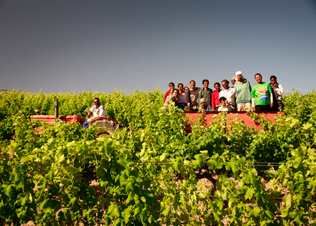News
Wine to watch: Vondeling
Friday, May 3rd, 2013
A clear blue sky stretches overhead as we bump along the lower slopes of the Paardeberg, on the dirt roads between Vondeling’s vines. “We call this the baboon block,” winemaker Matthew Copeland tells me, pointing out the outcrop high up the mountain, where the farm’s other residents like to hang out. I can see why. From up here, we have a bird’s eye view of the farm: some 40 hectares of vineyards, stretching across the valley to the brand new tasting room.
Purchased in 2000 by Julian Johnsen, and partners Anthony Ward and Richard Gower, Vondeling is still a relatively young winery. But its reputation has been growing over the past year or two: the wines are listed at local Top 10 restaurants The Test Kitchen and The Greenhouse, as well Albert Roux’s restaurants internationally.
In part, says Matthew, this is down to the location. Situated in the voor-Paardeberg region, the slopes are cooled by southwesterly winds that keep them around five degrees cooler than other surrounding areas. Then there’s the ground. As we bump along through the vineyard, Matthew points out the outcrops of granite, sticking up through the soil, and the lumpy, rocky soil on the road, which has the texture of porridge. “The granite soil gives the wine that freshness and flintiness, which is so key in the sauvignon,” he says, pointing out one block of gnarled sauvignon vines that date back to 1981 and 1984.
As we drive across the farm, the roads shift colour from grey granite to pale red and ochre in places, and Matthew explains that each of these soils have been carefully mapped and the different varietals suited to them.
Chardonnay and viognier are planted on the valley floor were the soil is alluvial; reds on the southwest and east-facing slopes where soils are rich in organic matter; and sauvignon and chenin in the granite-rich areas.
“Most of the wines we produce are blends,” Matthew explains. In the cellar – a converted milk shed – everything is compartmentalised in a range of relatively small tanks, which allows Matthew to single out individual blocks and carefully balance the wines.
It’s a remarkably hands-on process. The grapes are hand-picked by the five families which have lived on the farm for some time; the open-topped stainless steel tanks require hand plunging; and there’s also an old-fashioned basket press outside, which is still very much in use.
Aside from the baboons, Matthew tells me Cape leopard have also been sighted on the mountain, along with antelope, civet cats, caraculs and porcupine.
“We’re very conscientious about our mountain; it’s part of us,” says Matthew. The flagship white is named for a flower endemic to the Paardeberg, babiana noctiflora. And two years ago, the Paardeberg Sustainability Initiative, created by Julian Johnsen’s wife, Bridget, initiated a fynbos survey of the mountain, in which over 1000 different plant species were found and geo-tagged. More than 20 of these are critically endangered, and a few were actually thought to be extinct. Botanists also discovered an entirely new species, the name of which will be auctioned off to raise more money towards conservation.
All of this seems in keeping with Matthew’s philosophy of wine: to work in conjunction with nature, rather than fight against it. “You never master wine, you forge a relationship with it,” says Matthew. “When you try and force a wine to become something, you’re not going to do what you could have done in conjunction with nature.”
Later, in the newly opened tasting room, I get to taste the fruits of this strategy.
There’s a petit blanc – slightly floral with a hint of apple – and a lovely buttery chardonnay with a hint of citrus, peach-blossom and apple. The Babiana is a little more individualistic, and the different flavours peel back as it develops in the mouth. “It’s getting a bit of cult status,” says Matthew.
On the red side, there’s the Baldrick shiraz – named for the Rowan Atkinson series, Blackadder, and very popular, I’m told, with British gastropubs; the rewardingly complex Erica shiraz; a petit rouge; and a heady cabernet merlot, full of black cherry, smokiness and crème de cassis.
After a lunch in the tasting room, we taste the estate’s straw wine, Sweet Carolyn, which boasts 4.5 Platter stars. It’s downright delicious, like a pudding. It has a beautiful caramel colour with sweet fruit, orange blossom, jasmine and fynbos honey notes.
Considering the number of gold stickers, Platter stars and spots in the Top 100, Vondeling wines are all pretty well priced, too.
“Because we’re youthful, we’re good value at the moment,” explains Matthew. Considering the quality of the wines, I’d say it’s time to stock the cellar.
Want to try Vondeling wines? Head to Wine Concepts, Vino Pronto, and Makro and Ultra stores, or try them at Cape Town restaurants The Greenhouse, The Test Kitchen and Bacini’s.












